Andrew Kramer
University of Colorado, Boulder
Planetary rovers require the ability to create a map of their environment and localize themselves within that map. As rovers are sent deeper into our solar system long round-trip communication times will make close human supervision impractical. This means higher levels of autonomy are required. Feature-based visual SLAM is one of the fastest and cheapest methods available for autonomous localization and mapping. However, the performance of visual SLAM suffers when faced with optical elements such as specular highlighting, shadowing, and haze. The ability to make use of these phenomena is critically important in potential future projects such as rover exploration of the icy surface of Europa. The proposed work would enhance visual SLAM by leveraging information from these elements to increase localization and mapping accuracy. The ultimate goal of the proposed work is the creation of a visual SLAM algorithm that incorporates information from shadows and specular highlights to refine its model of the environment, providing increased accuracy and consequently a higher level of scene understanding and autonomy.



























